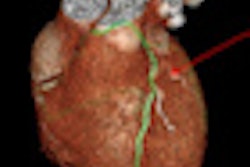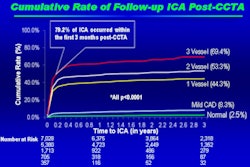Coronary CT angiography (CTA) is the most cost-effective way to diagnose patients with chest pain and suspected coronary artery disease, according to a new study in the March issue of Radiology.
CTA alone followed by invasive coronary angiography for positive findings beat out four other diagnostic approaches involving SPECT myocardial perfusion imaging (MPI) in combination with CTA or invasive angiography.
The multicenter study was performed at Weill Cornell Medical College in New York City, along with Harbor-UCLA Medical Center and Cedars-Sinai Medical Center, both in Los Angeles.
Lead author and Weill radiologist Dr. James Min and colleagues' previous study (Assessment by Coronary Computed Tomographic Angiography of Individuals Undergoing Invasive Coronary Angiography [ACCURACY]) showed high detection sensitivity and negative predictive value.
The present study, which focuses on the role of SPECT MPI, models the ACCURACY-eligible population "to determine the incremental costs per correct diagnosis and per quality-adjusted life years (QALYs) saved for noninvasive imaging strategies that do or do not incorporate coronary CT angiography," wrote the authors (Radiology, March 2010, Vol. 254:3, pp. 801-808).
Min and colleagues Amanda Gilmore, Ph.D., Dr. Matthew Budoff, Dr. Daniel Berman, and Ken O'Day, Ph.D., compared five diagnostic approaches for chest pain patients without known coronary artery disease (CAD):
- Coronary CTA followed by invasive coronary angiography for positive or equivocal findings (coronary CTA only)
- Coronary CTA followed by invasive coronary angiography for positive findings and myocardial SPECT for equivocal findings (coronary CTA first)
- Myocardial perfusion SPECT followed by invasive coronary angiography for positive/equivocal findings (myocardial perfusion SPECT only)
- Myocardial perfusion SPECT followed by invasive coronary angiography for positive findings and coronary CTA for equivocal findings (myocardial perfusion SPECT first)
- Invasive coronary angiography only
All analyses were conducted from the payor perspective, both for the near-term diagnostic period and a long-term lifetime period.
The diagnostic analysis used test sensitivity, specificity, rates of equivocal results, and disease prevalence to classify patients undergoing coronary CTA and SPECT, the group noted. Any patients with either positive or indeterminate findings were assumed to be referred for invasive angiography, which was assumed to have perfect sensitivity and specificity for purposes of the study, Min and colleagues noted.
The study's second, postdiagnosis analysis used a Markov model based on one-year cycles to assess outcomes and costs for patients correctly diagnosed by any modality with coronary artery disease. The model's base case was a 55-year-old man with 30% risk of obstructive coronary artery disease (≥ 50% stenosis), and the authors further classified disease as absent, mild, moderate, or severe, analyzed by vessel in each patient.
The researchers based CTA's performance in the model on the previous ACCURACY trial results, while SPECT sensitivity and specificity were based on American College of Cardiology (ACC) et al's Guidelines for the Clinical Use of Radionuclide Imaging.
The results showed that for near-term diagnosis, the least expensive strategy was coronary CTA first (No. 1 above), yielding an expected 982.1 correct diagnoses per 1,000 patients at an average cost of $1,770 per patient, including incidental findings.
However, the CTA-only strategy (No. 2 above) was more effective, yielding 986.3 correct diagnoses per 1,000 patients at an average cost of $1,842 per patient and an incremental cost-effectiveness ratio (ICER) of $17,516 per correct diagnosis, the authors reported.
Both SPECT strategies -- myocardial perfusion SPECT-first (No. 3 above) and myocardial perfusion SPECT-only strategies (No. 4 above) -- "were more costly and less effective than either coronary CT angiography-based strategy and were ruled out by using simple dominance," the authors wrote.
The most effective but also most expensive strategy was invasive coronary angiography, which yielded 999 correct diagnoses out of 1,000 patients, but at an average cost of $2,771.
Cost differences according to the ICER results were stark. Compared with coronary CT angiography only, the ICER for invasive coronary angiography was $73,175 per correct diagnosis, the group reported.
For long-term cost-effectiveness, a coronary CTA-only strategy demonstrated a favorable ICER of $20,429 per QALY relative to the least expensive coronary CTA-first strategy, the group wrote. "Both myocardial perfusion SPECT-only and myocardial perfusion SPECT-first strategies were more costly and less effective than either coronary CT angiographic strategy," Min said.
Test performance was an important factor in the long-term results, which were sensitive to coronary CTA sensitivity, myocardial perfusion SPECT sensitivity, and the prevalence of coronary artery disease.
The results also showed that CTA's dominance was robust. The CTA-first and CTA-only strategies remained dominant up to a baseline CTA cost of $1,100 and coronary artery disease prevalence as high as 80%.
"The most cost-effective strategy for patients who have chest pain with an intermediate prevalence of obstructive CAD is initial evaluation by using coronary CT angiography, followed by invasive coronary angiography for severe CAD or equivocal test results," Min and colleagues wrote. "In patients with lower prevalences of CAD, a coronary CT angiography-first strategy -- employing coronary CT angiography followed by invasive coronary angiography for abnormal coronary CT angiographic findings and myocardial perfusion SPECT for equivocal coronary CT angiographic findings -- is the most cost-effective strategy."
When disease prevalence is very high (> 80%), invasive coronary angiography becomes the most cost-effective approach.
Regardless of CAD prevalence, however, "a diagnostic strategy employing myocardial perfusion SPECT as an initial diagnostic test was more costly and less effective," the group wrote.
The authors excluded several other common heart tests including echocardiography and cardiac MRI, stating that inasmuch as four out of five imaging tests in the U.S. are SPECT myocardial perfusion, it was this test that merited the cost-analysis focus, which the authors said was the first to look at both short-term diagnosis and long-term outcomes in a multicenter setting.
Individuals without known CAD and with intermediate prevalence incur "lower near-term costs per correct diagnosis and long-term costs per QALY by using coronary CT angiography-based strategies," they concluded. "In particular, application of coronary CT angiography as a standalone test -- rather than in combination with other noninvasive imaging tests -- is most cost-effective."
By Eric Barnes
AuntMinnie.com staff writer
March 2, 2010
Related Reading
Analysis favors coronary CTA over stress MPS for chest pain, January 15, 2010
Patients with peripheral arterial disease may need cardiac imaging, December 30, 2009
Echocardiography test beats SPECT for predicting problems after MI, December 7, 2009
Using coronary CTA first versus SPECT cuts costs, May 30, 2008
Coronary CTA cuts costs for chest pain care, February 29, 2008
Copyright © 2010 AuntMinnie.com




















